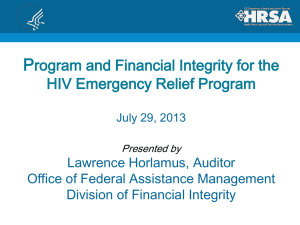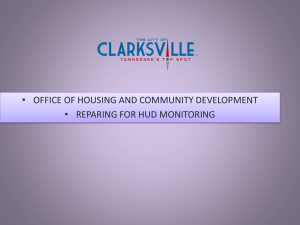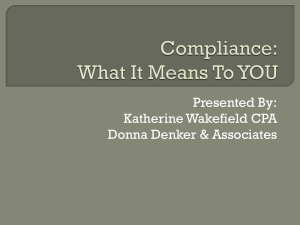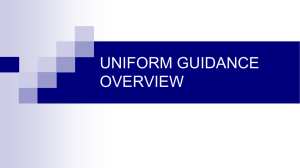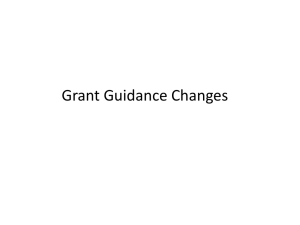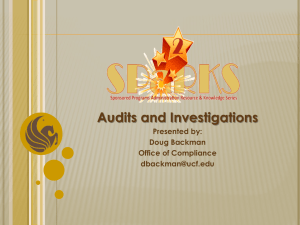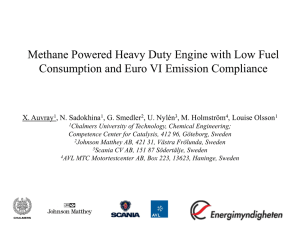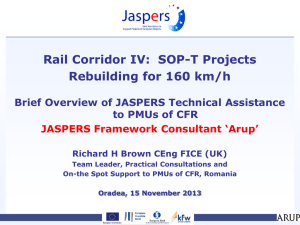CCIP: ODE Office of Grants Management
advertisement
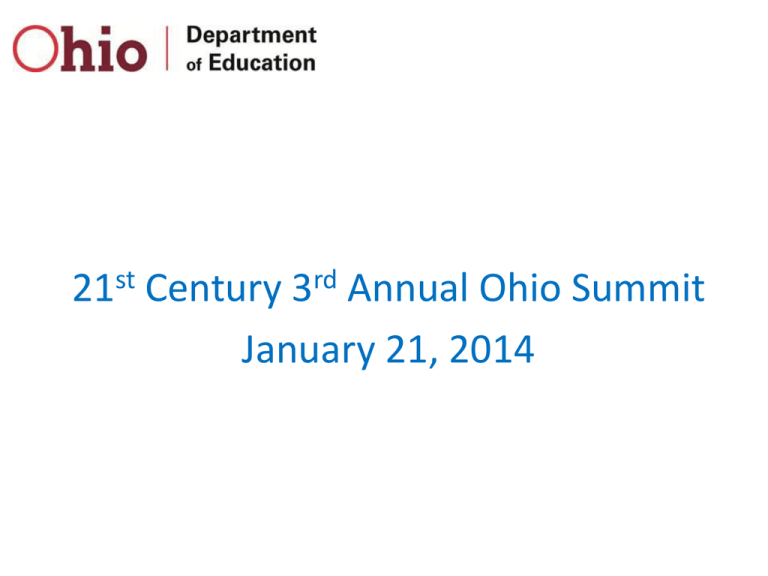
21st Century 3rd Annual Ohio Summit January 21, 2014 Office of Grants Management 25 South Front Street Mail Stop G03 Columbus, Ohio 43215-4183 (614) 752-1483 Brian Jones, Director brian.jones@education.ohio.gov Yolanda Mitchell, Grants Management Supervisor yolanda.mitchell@education.ohio.gov Lois Sunderland, External Audit Supervisor lois.sunderland@education.ohio.gov Tiffany Davis, Grants Administrator tiffany.davis@education.ohio.gov Purpose of Grants Management (GM) • Consultant Project Cash Requests (PCR) Final Expenditure Reports (FER) Federal Requirements (EDGAR) (GM) Business Rules • Subrecipient Monitoring (SRM) SRM vs Single Audits (A-133) Basics to Prepare for SRM Trending Statewide Issues/Findings • Grants Administration Indirect Cost Rate Time & Effort Combined Federal Circular Fun Facts Questions GM Consultanting • • • • • • • • Substantially Approved Dates When an obligation is made Budget Revisions Period of Availability Support Documentation FERs and FER Revisions Assurances Important Dates Subrecipient Monitoring Sub-recipient Monitoring (SRM) vs Single Audits (A-133) Subrecipient Monitoring -is the process of providing oversight on subawards throughout their lifecycle including: A. Monitoring the activities of its subrecipients (Grantees) B. Ensuring that Federal awards are used in compliance with laws, regulations and the provisions of the grant provisions. C. Ensuring performance goals are achieved. Single Audit Act (A-133)- A single audit is an organization-wide audit that includes both the entity's financial statements as well as its federal awards. Effective January 2004, The Office of Management and Budget Circular No. A-133, Audits of States, Local Governments, and Non-Profit Organizations, requires entities that expend $500,000 or more a year in federal awards to have a single or program-specific audit conducted. Basics to Prepare For SRM: • Proper Support Documentation (Invoices, Cancelled Checks, Time & Effort, Semi-Annual Certs, etc…) -34 CFR 80.20-(b) (1) & (2) Standards for Financial Management Systems. 3-yr record retention • Inventory Management -34 CFR 80.32. – Proper tags & Serial #, Physical Inventory every 2 yrs • Accounting to conform to a data coding structure (i.e. USAS-Uniform School Accounting System) – OAC 3301-19-03(A). – AOS mandates that each entity must enter an expenditure with proper code classification 3-digit object code and 4 digit Function/Purpose • Proper use of Budget and Budget Revisions– 34 CFR 80.30 C(ii). – GRANTEE MUST OBTAIN PRIOR APPROVAL IF ACTIVITIES ARE EXPECTED TO EXCEED 10% OF THE CURR TOT APPR BUDGET Trending Statewide Issues 1)Lack of or incomplete Time & Effort forms/Semi-Annual Certifications. • 2 CFR 225 Appendix B 8.g. (1-3) Where an employee work on multiple activities, A Fed award and a non-Fed award, 2 or more indirect activities = T&E • Where are expected to work solely on a single Fed award=Semi Annual certs 2)Cash Management & Time Lapsed between payments. 34 CFR 80.20 (b)(7) and 80.21 (c ) 3)Obligations/Period of Availability (POA) 34 CFR 80.23- Ensure expenses are incurred within the project period 4)Activities Allowed or Unallowed 34 CFR 80.22 –Allocable Costs and 2 CFR Part 225 Appendix A-Section c(3)(a) and C(1)(a-j) Costs that are: – Reasonable, allocable, necessary, & compliant Grants Administration Indirect Cost Rate (ICR) • • • • • What is an Indirect Cost Rate What is it used for Restricted vs Unrestricted Rates How to apply for an ICR How to Utilize an Approved ICR in CCIP Time & Effort • When an employee works on multiple cost objectives (different federal funds) they must maintain a distribution of their salaries. This has been done by maintaining time and effort documentation (personal activity reports), where the employee associates the total hours worked during the pay period to a specific activity and/or funding source. Failure to complete and retain proper documentation could result in questioned costs with the potential of loss of funds for the LEA. • Based on feedback to reduce the burden of this time and effort documentation, USDOE is allowing ODE to develop substitute systems for tracing required information. An LEA may submit proposed documentation for personal activity reports that contains the required components. Once the proposed documentation is reviewed and approved, the LEA will receive notification that their plan is acceptable and will be able to use their new format. – – – – Current Requirements They must reflect an after-the-fact distribution of the actual activity of each employee They must account for the total activity for which each employee is compensated They must be prepared at least monthly and must coincide with one or more pay periods They must be signed by the employee New Flexibility – Allows for a hybrid of semi-annual certifications and employee “calendar” • • • Indicate the specific activity or cost objective that the employee worked on for each segment of the employee’s schedule Account for the total hours for which each employee is compensated during the period reflected on the employee’s schedule Be certified at least semiannually and signed by the employee or a supervisory official having firsthand knowledge of the work performed by the employee Combined Federal Circular Combined Federal Circular – • 2 CFR 220 - Uniform Administrative Requirements, Cost Principles, and Audit Requirements for Federal Awards • Applicable to FY16 • Designed to strengthen requirements for internal controls while providing administrative flexibility for non-Federal entities, does not change or modify existing statutes • Combines similar language from separate guidances for different entity types under one umbrella • Combines and streamlines OMB Circulars (Federal funding guidance) • – – – A-87 A-102 A-110 – – A-122 A-133 Cost Principals for State, Local and Indian Tribe Governments (relocated to 2CFR 225) Grants and Cooperative Agreements with State and Local Governments Uniformed Administrative Requirements for Grants and Other Agreements with Institutions of Higher Education, Hospitals and Other Non-Profit Organizations (relocated to 2 CFR 215) Cost Principles for Non-Profit Organizations (relocated to 2 CFR 230) Audits of State, Local Governments and Non-Profit Organizations Selected changes/clarifications in the combined circular – – – – – – – – Requirements for Pass through Entities (ODE) - requires pass through entities to consider risks associated with awarding grants such as financial stability, quality of management systems, history of performance, reports and findings from audits and reviews, and the entity’s ability to effectively implement statutory, regulatory or other requirements Conflict of Interest – language added that requires non-Federal entities to disclose in writing any potential conflicts of interest Supplies – clarifies the threshold for defining personal property as supply vs equipment Compensation of Personal Services – strengthens requirements to maintain internal controls over salary and wages while allowing for additional flexibility in the form of alternative time and effort documentation Conferences – clarifies allowable conference spending Employee Health and Welfare Costs – eliminates allowance for morale costs Audit Requirements – raises the Single Audit Threshold from $500,000 to $750.000 Appendix III through VII clarify indirect cost activities and reporting Questions?
